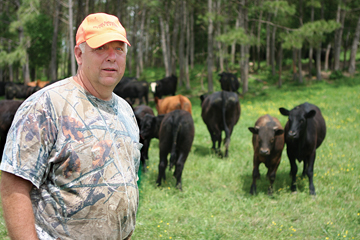Diminishing Returns Force Cow-Calf Producers To Rethink Production

When the phone rings on Perry Mobley’s desk these days, he knows it’s very likely a cow-calf producer wanting to know one thing: “How are we going to make it with $4 a gallon diesel fuel, $7 a bushel corn and $700 a ton fertilizer?”Mobley, director of the Alabama Farmers Federation’s Beef and Hay and Forage Divisions, admits he doesn’t have an answer — at least not an easy one.”The model for the cattle industry was built on cheap corn and cheap fuel, but the model is broken,” said Mobley. “I don’t think we’ll ever see $2.50 a bushel corn and $1.50 a gallon diesel fuel again.”Neither does Dr. Walt Prevatt, Auburn University professor and Extension economist, who says the three F’s — fuel, feed and fertilizer — have become a triple threat to the state’s cow-calf operators, and could very well force some out of business.What’s more, Prevatt says the outlook is just as dire — maybe even moreso — for pork and poultry producers.
“I’m not trying to paint an extreme picture here,” Prevatt said. “It’s real, and it’s going to impact the industry. We thought the droughts of the last two years were bad, but this is going to be a lot tougher.”Prevatt predicts a continuing decline in market prices with cow-calf producers seeing prices 5 to 10 percent lower. “That’s a significant hit,” said Prevatt. “That would be somewhere between $25 to $50 cheaper per calf. For someone with 100 head, that’s $2,500 to $5,000 less revenue than they would normally realize in 2008.”On top of the diminishing revenue, Prevatt said, cow-calf producers will see production costs soar as much as $7,500 to $12,500 per 100 head.”The high cost of feed has hit the people who are feeding cattle really hard, and they’re the ones who are going to dictate what calves bring because they are the ones who’ll wind up with them in the end,” said Tim Tucker of Monroeville, chairman of the Federation’s State Beef Committee. “As for myself, I can’t believe it’s not already worse than it is. I hear folks saying that it’s going to bounce back, but I don’t see any bouncing anytime soon.”Neither do Ray and Delle Bean who run a cow-calf and poultry operation on the rolling farmland of Calhoun County. “Delle and I don’t see any profit at all in the beef industry for the next two years,” said Ray, adding that he’s already decreased his usual 300-head herd to 200 due to the drought and will likely further reduce the herd. “If I can’t produce enough hay with what (poultry) litter I have, we’ll drop our numbers down to cover that because the profit’s just not there to buy feed. We just can’t do it.”So what happened?”You can’t blame the corn farmer. You can’t blame the soybean farmer,” said Mobley. “Everybody in agriculture is hurting right now.” “The pork industry actually has it worse than we do because their production is 10 percent ahead of last year, and poultry is 6 percent ahead,” said Prevatt. “So, we’re feeding more animals and further stretching the grain stock.”Prevatt says the situation is due to several factors: A drought in Australia, increased pork and poultry production, an energy initiative that nudged up grain prices, reduced grain stocks in other parts of the world, China doubling its per capita meat consumption since 1990 and a weakening dollar which knocked an already precarious trade balance out of whack. “It is not a market correction,” said Prevatt. “We are in a new production era. These energy initiatives are good through 2012, so these higher grain prices are not going to go away. What we are going to have to do is adjust our production system so that we can get back to a profitable situation.”For decades, that “production system” for Southeastern cow-calf producers has worked like this: Ship the cattle to the corn for fattening and harvest. But lately, transportation costs have turned that system upside down, making it cheaper to bring the corn to the cattle. Trouble is, there are few packing houses to harvest Southeastern cattle, and the price of feed remains high regardless of where the cattle are feeding.Mobley says this “new production era,” as Prevatt calls it, calls for rethinking how Alabama cattlemen have always done business. “We’ve got to figure out how to be more efficient producers because we are at a great competitive disadvantage as far as transportation,” said Mobley. “We’ve got to figure out how to put more efficient weight gain on cattle for longer periods of time using forage crops, but we’ve got to be able to do that without using a lot of commercial fertilizer because the cost of that has doubled in the last year.””I don’t think we need to move to a different breed of cattle,” Mobley added. “We just need to select cattle that will perform as well on grass as they will on a concentrated feed ration. We need to utilize legumes in our pasture mixes so we don’t have to rely so heavily on commercial nitrogen.”Mobley and Prevatt both say that the time may be ripe for Alabama farmers and ranchers to focus on the grass-fed beef industry. “We need to emphasize more grass rather than grain,” said Prevatt. “Rather than carrying one cow to every two acres, we’re probably going to have to carry a cow to every three acres.””We all like to see that roly-poly, fat, slick, pretty animal you envision when you eat a steak with good marbling,” said Bean. “But it’s not going to happen on grass. It’s going to take some learning on my part. We’ve tried some beef on grass, but it wasn’t finished the way it needs to be. But we’re going to have to do something different or we’re not going to be in business much longer.”
